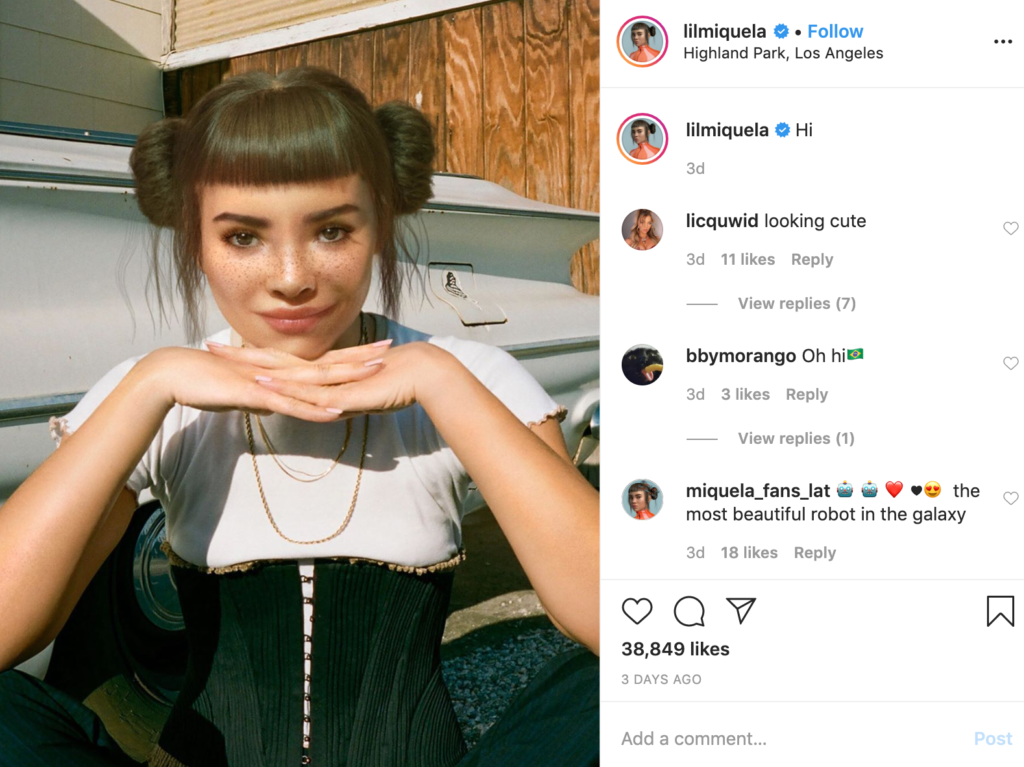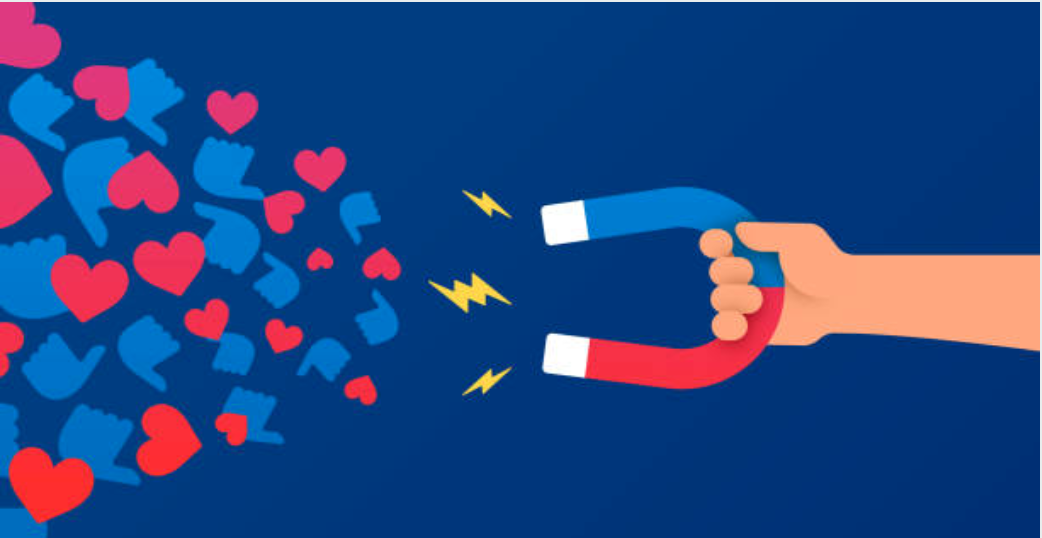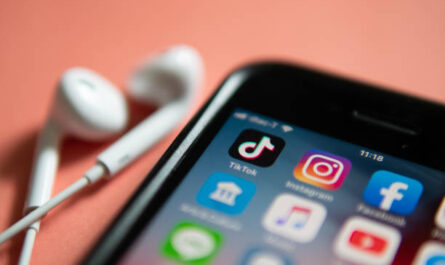By Kyra Lindsay
How can you tell which influencers are actually influential or who might actually have false content or misleading following? Looking back at our lecture with Bill Calder and Jenna Galbreath, from WE communications, we see how we can look to insights in order to understand influence.
When taking a glance at an Instagram influencer with millions of followers, it is usually safe to assume that they are not only real but have influence – or clout to spread among their following. What do we do when not only is the content not real, but the creator is not either?
Back in 2016, an Instagram model appeared that caused a divide within a community. User Lil Miquela, who seemed to be either too perfect to be real or such a lifelike animated character was born and was out marketing different brands as well as her own music. By the end of 2018, the @lilmiquela account had over a million following the fictitious figure.

Famous YouTuber Shane Dawson even got involved in the conspiracy of whether or not Miquela was a real person or not and addressed it in multiple videos.
The main point of Miquela was that she showed what most already knew. Not only do you not need real followers, but you do not need a real influencer either. We saw this as well when an egg beat Kendall Jenner for the most-liked picture on Instagram. It is not the person that makes the influence, but rather what it stands for. Miquela was the first artificial influencer, but I am certain she will not be the last.



This is very interesting, prior to this class I would assume anyone with any real influence would have to be real and it would be impossible for any bought to gain popularity. Clearly, this is not the case in today’s era of social media and digital marketing. It is funny you brought up the egg, because I have always wondered how it got so many likes, and the publicity it takes to be able to accomplish that. It is surprising how many followers are bought, yet I don’t think you can purchase likes the same way. Thanks to the presenters this week its easier to detect what person or bot is real and most influential.
Hi Kyra,
I really enjoyed reading your post! This idea of real users vs. bots is something I never knew about when I first began using platforms like Instagram. As I have learned more about the platforms, I definitely agree that it no longer takes a real person or genuine content to gain a following; however, I still see a lot of the influence on social media to be artificial. Nowadays, it can be hard to decipher not only if an influencer is real, but if their “influence” is genuine and organic or not. I believe that there will be some push back in coming years that will redistribute the power and influence of social media and its users in order to overcome the inorganic issues on some of the platforms.
This is a really interesting topic. To begin with, I think it is ridiculous that people have fake followers and fake accounts. It is wild that these fake accounts can get such large followings, which is why I think social media has such a large influence. These accounts, that are not real, can post content that reaches people. To echo previous comments, I agree that at some point there will be push back to figure out to redistribute the power and access social media has over the public.
This is a strange phenomenon to me. The idea of bots being able to produce a hefty following that helps bring a random person’s account to the forefront of influences is crazy to think about. However, going off of that I think it is wise for any brand to consider the followers, where did they come from can you trace growth across the account in a way that would make sense? By this is mean looking into potential influencers and the very basics of social media analytics, if one day you notice that this account is garnering hundreds or thousands more likes than prior that would feel strange, it would be something any brand should be considering when thinking about influencers.
I enjoyed this post and I’m glad you touched on this topic. When I learned about people have fake followers and buying likes, I thought it was very strange. And brining in a bot instead of a real person makes it even more wild. It is interesting to see which people read into these things and realize what is actually being done, versus people who think it’s real content. With technology and other resources we have today, it is becoming easier and easier to recognize how social media content is working, and I believe it will continue to grow in this way.
Kyra,
I found this post really interesting because I remember when everyone was talking about Lil Miquela’s because Shane Dawson brought her into the spotlight. I remember my friends and I all following her on Instagram because we were all so intrigued by her mystery. The concept of Miquela being a famous influencer with a brand, huge following as well as a means to make money is insane, given the fact she is not even a real human. This to me shows just how influential brands and social media content can be in society, as well as how widespread content can become.
I honestly think this phenomenon of influencers not being real people started with holograms and the like in Japan, with fictitious singing idols like Hatsune Miku, a voicebank that’s part of a vocal “group” of other fictitious “singers.” The only difference between Hatsune and Lil Miquela is how life-like Lil Miquela looks. I think the use of these kinds of real but unreal figures – especially since her appearance fits into the realm of the uncanny valley – will only be more used as brands look for “people” to represent them. Honestly, I wouldn’t be surprised if Wendy’s did something along these lines and developed an influencer to model after the “girl” in their logo….
I thought this article was so thoughtful with the current social media climate where everyone and their mother is becoming an Instagram influencer or promoting something. And after hearing the presentation by Jenna and Bill in class about the best influencers for a product based on data, and what influence bot followers can have on this, I got to really thinking. Especially when Jenna put 4 possible influencers up on the board and compared their reach and engagement statistics, and she noted that Kylie Jenner, who has an incredibly large Instagram following, had an immense amount of these bot-fake followers. Which makes me question if brands like Sugar Bear Hair and Fab Fit Fun who are so widely promoted by Instagram influencers take into account possible bot-followings for big names like Kylie Jenner or if they just hope the possible reach of the post will overpower who exactly the post is reaching.
I’d strongly agree with your viewpoint Kyra. It’s hard to grasp what defines an “influencer” in today’s society. Many of the trends that we consume in society our influenced by figures who obtain authority. How exactly that authority was gained being the main question – through actual impact or self proclaimed fame and looks? I personally have chosen to enlighten myself and those around me to indulge in content with influencers that are seeking to socially influence change within pop culture and todays society.
Hi Kyra,
Thank you for your blog post! I thought that it was very interesting and thought-provoking to read. I think that you aptly labeled Lil Miquela as an artificial influencer. I remember when Lil Miquela was a big topic of discussion, and I thought it was so eery how real she looked. If you don’t look too closely, she would pass as being a real human! So I think of people who are scrolling through their feed, just glancing at the content and hitting the like button, not even knowing that they are supporting a robot and not a human. But for the people who knew that she was a robot and still supported it, I think it was because she was something so out of the ordinary that it caught peoples’ interest. The same is true for the egg. Sometimes with social media, content can start to feel a bit repetitive or insignificant, so when something comes along that is unique, novel, way out of the box, and even a little strange, that attracts attention and stimulates a conversation.
Thank you for your insights!
Great post Kyra!
This topic is very interesting and does a great job of articulating what ‘true’ influence really is. Is it a person? An idea? A brand? As a marketer, it is critical to understand this and how you want to leverage this concept to achieve a certain outcome. I think, regardless of what is influential, associating yourself with something must be determined by the degree of authenticity. If it makes sense to sponsor the ‘egg’ account on social media, then go for it. But do not do it, strictly because it has over a million followers. This is where marketers go wrong and face negative ramifications. Consumer trust is hard to earn and can easily be lost if not it’s not valued appropriately.
This reminds me of the argument that we won’t need actors by year 2050. So much is CGI, and if you ever look at behind the scene footage of many recent films, it looks like actors are wearing pajamas in an all green box. With how many movies are dealing with the past, future, etc., face remapping has never been more apparent. By that same time, will we not need human influencers too?
Social media first and foremost is entertainment. If people like what they see, they may like or comment. In most cases they probably don’t care too much if the character is real or not. When the rhetoric shifts towards the feeling of being deceived, that can go very badly for whatever brand is associated with that character. No one wants to be outright deceived of course, but as technology and the social landscape shift over time people will be more and more comfortable with characters created by CGI.
Echoing what some of the others have said, what makes you a “success” on social media has little to do with your authenticity; it’s all about entertainment. To be a successful influencer doesn’t necessarily require any form of vetting. I’ll be curious to see as society becomes more desensitized to influencer culture if we see this starting to shift majorly.
Hi Kyra,
I really liked when you said, “It is not the person that makes the influence, but rather what it stands for.” I think that influencers on social media have so much power to influence people, but they also have the ability to mislead people. When you talk about fake influencers, people could admire them and be mislead into the information they provide. It is hard to know when someone is fake on social media with all of the updates with technology and editing features. But, the influencers that are real do have some great influence on their followers.
I really enjoyed reading this especially because you touched on the difference between being an actual influencer, or just having the qualities that influencers are known to have (for example, the millions of followers). I think when we really analyze the true meaning of an influencer we should be directed to more legendary icons such as Kobe Bryant, Serena Williams, Sabrina Ionescu, and so forth. When reading this I personally think of influencers being defined as two separate categories, such as one of the categories being responsible for selling something and making money whereas the other version can be seen as someone making actual history and having a global impact. I really enjoyed being able to relate the two categories while following along this article.
Very interesting post, do you know where I can buy followers? All jokes aside I think that you bring up a great point in regards to how important what you stand for is. Being an influencer is subject to mass approval and that can be taken away with a shift in culture or by you’re own doing. I am curious to see how influencer marketing develops over the next 5-10 years as we move into an era of kids that were raised by social media…. born in it. How data is distributed to display real users vs fake users could become a factor in how companies choose to partner with influencers. My guess is that micro influencers might become much more valuable to target a more focused group.
This topic is really interesting and really puts into perspective how we perceive other people online. Nowadays it’s hard to decipher what is and isn’t real on social media. I also think tho that things are changing now that Instagram has taken the initiative to hide likes from followers now. I think this will decrease the number of bot likes because the incentive to increase a number of likes is eliminated. Although it doesn’t really fix the issue of people getting fake followers since that number is still visible to everyone.
It took me a lot more scrolling than it should have to realize you literally meant Miquella isn’t real. It’s a weird feeling when a CGI bot has millions more followers than you… I think it’s entirely possible to be ‘fake’ but have real influence. Sponsorships, celebrity features, and real life locations within the account’s activity blur the lines a bit and really allow Miquella to have the same impact on the world as any other IG model… trippy.
Hi Kyra!
This is a really interesting way of talking about influencer branding! I have heard of another Instagram influencer that is similar to Lil Miquela and it intrigued my interest. However, I am curious if you thought about the fact that real followers do matter. The issue with fake followers/fake social media accounts is that they do not share the influence with others. When a real person views something influential, they often share the post or talking about it/the person with their friends. That is how real influence is created and spread. However, there has not been a platform created that can weed out fake accounts while measuring influence.